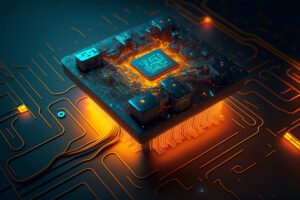FPGAs, or field-programmable gate arrays, have revolutionized a variety of sectors and have broad uses. Among these, the healthcare industry is at the vanguard, realizing the enormous potential of FPGA in improving diagnostics and medical equipment.
FPGAs provide reconfigurability and parallel processing capabilities, which are benefits over traditional hardware solutions like ASICs and CPUs. This enables the creation of highly customized and effective solutions catered to particular healthcare requirements.
Real-time data processing and patient care have advanced dramatically as a result of the incorporation of FPGA technology into diagnostic equipment and medical devices. FPGA developments have benefitted implantable neuroprosthetics, wearable health devices, and medical imaging systems.
This investigation digs into the world of FPGA in healthcare, revealing its significant influence on diagnostics and medical equipment.
We will go into the foundational ideas of FPGA technology, its uses in different medical devices, and its function in real-time diagnosis. Additionally, we will evaluate the benefits, difficulties, and potential applications of FPGA in healthcare while also taking the technology’s ethical and societal ramifications into account.
By the end of this journey, we hope to illuminate how FPGA is reshaping healthcare to make it more patient-centric, efficient, and accessible.
FPGA Applications in Medical Devices
FPGAs (Field-Programmable Gate Arrays) have found numerous applications in the field of medical devices, revolutionizing healthcare by enhancing the performance, flexibility, and functionality of various medical instruments. With their ability to be reprogrammed and customized for specific tasks, FPGAs have become a critical component in a wide range of medical devices. Here are some key areas where FPGA applications have significantly impacted medical devices:
1. FPGA-based Imaging Systems:
Planning a diagnosis and course of therapy both heavily rely on medical imaging. In order to process and recreate complicated image data in real time, imaging systems frequently use FPGAs. Several instances include:
a. Ultrasound Devices: FPGAs enable real-time beamforming and image processing in ultrasound machines, providing clearer and more detailed images for accurate diagnosis.
b. X-ray and CT Scanners: FPGAs facilitate advanced image filtering and noise reduction techniques, leading to improved image quality and lower radiation doses for patients.
c. MRI Machines: FPGAs are used for real-time data processing in MRI systems, enabling faster image acquisition and reconstruction while maintaining image quality.
2. FPGA-enabled Wearable Medical Devices:
For ongoing patient monitoring and surveillance, wearable medical gadgets are becoming more and more common. These devices are improved by FPGAs, which offer high-performance computing and power-saving features. Examples comprise:
a. ECG and EKG Monitors: FPGAs enable real-time processing of ECG signals, detecting abnormalities and providing immediate feedback to patients and healthcare professionals.
b. Blood Glucose Monitors: FPGAs assist in accurate glucose level measurements and rapid data analysis, helping patients manage diabetes more effectively.
c. Wearable Health Trackers: FPGAs are utilized to process sensor data, track physical activity, monitor vital signs, and analyze sleep patterns for health and fitness applications.
3. FPGA in Neuroprosthetics and Implantable Devices:
For people with disabilities, neuroprosthetics and implantable devices are designed to replace lost capability or enhance quality of life. Because they allow for real-time signal processing and customisation, FPGAs are essential in these devices. Examples comprise:
a. Cochlear Implants: FPGAs process sound signals to stimulate the auditory nerve, allowing individuals with hearing impairments to perceive sound.
b. Deep Brain Stimulation (DBS) Devices: FPGAs regulate electrical stimulation patterns to manage conditions like Parkinson’s disease and essential tremors.
c. Retinal Implants for Vision Restoration: FPGAs process visual input and stimulate the retinal nerves, restoring partial vision to individuals with retinal degenerative diseases.
FPGAs provide significant benefits in all of these applications. They can be modified to conform to shifting medical needs, ensuring that devices stay current with the most recent developments. FPGAs also offer high-speed processing with low latency, providing the real-time responses necessary in medical environments. Additionally, because they can handle parallel processing activities, they are the best choice for handling sophisticated algorithms and data-intensive medical applications.
Advantages of Using FPGAs in Healthcare:
High Performance and Low Latency: FPGAs provide low-latency data processing and high-performance computing capabilities. Real-time processing is essential in medical applications, particularly for patient monitoring and diagnosis. FPGAs are suited for time-sensitive activities because they can swiftly carry out complex algorithms and provide prompt results.
Customizability and Flexibility: ASICs (Application-Specific Integrated Circuits), which are fixed hardware solutions, cannot be customized or reprogrammed like FPGAs can. Medical devices frequently need customized features to meet the demands of individual patients or change with developing medical procedures. FPGAs offer a great degree of flexibility because they are simple to upgrade with new algorithms or protocols.
Power Efficiency and Portability: FPGA-based systems can be developed to optimize power usage, which is crucial for battery-operated or portable medical devices. FPGAs can help with improved battery life and lower energy usage by implementing only the capabilities that are required and removing unnecessary parts.
Real-time Processing Capabilities: FPGAs are excellent at real-time signal processing, which makes them suitable for jobs that call for quick outcomes, including monitoring vital signs, analyzing biosignals, or responding to life-threatening medical situations. Real-time data processing has the potential to save lives by enabling quicker diagnosis and prompt actions.
Parallel Processing: Due to the parallel processing capabilities of FPGAs, many tasks can be carried out concurrently. Applications using medical imaging that require the speedy processing of large amounts of data can benefit from this capacity. The efficiency of medical picture reconstruction and analysis is improved by parallel processing, which also cuts down on overall processing time.
Limitations of Using FPGAs in Healthcare:
Design Complexity and Time-to-Market: The design process is challenging and time-consuming due to the specialized knowledge and abilities needed to create FPGA-based medical solutions. Longer development times and more expensive startup expenditures may result from integrating FPGA technology into medical devices or diagnostic instruments.
Verification and Validation: It is crucial to guarantee the dependability and safety of medical systems built on FPGAs. To identify and correct potential design faults or errors, thorough verification and validation techniques are necessary. The necessity for extensive testing may cause the development schedule to be further extended.
Regulatory Compliance and Safety Standards: To guarantee patient safety and data confidentiality, FPGA-based medical devices must abide by stringent regulatory criteria and safety standards. It can be difficult to obtain regulatory approval, particularly when using innovative FPGA-based technology.
Cost: FPGAs can cost more than ready-made fixed hardware solutions even if they offer customization and flexibility. Financial difficulties could arise from the upfront development costs, which include FPGA hardware and specialist design tools, particularly for startups or smaller healthcare organizations.
Resource Utilization: To get the best performance, FPGA resources must be used properly. Power efficiency and overall system performance can be negatively impacted by inefficient resource management, which can result in underutilization or excessive resource consumption.
Limited Domain Expertise: The successful implementation of FPGAs in healthcare relies on skilled engineers with expertise in FPGA programming and medical domain knowledge. The scarcity of professionals with these dual skills can hinder the widespread adoption of FPGA technology in healthcare.
FPGA Applications in Medical Diagnostics
FPGA (Field-Programmable Gate Array) technology has found widespread applications in medical diagnostics, revolutionizing the way healthcare professionals analyze and interpret patient data. The ability of FPGAs to perform real-time signal processing, parallel computations, and hardware acceleration has made them a valuable asset in various diagnostic tools. Here are some key areas where FPGA is being utilized in medical diagnostics:
A. FPGA-based Diagnostic Tools:
Point-of-Care Testing Devices:
Point-of-care (POC) testing is the name given to medical diagnostic procedures carried out close to the patient and delivering quick results for prompt decision-making. These devices rely on FPGAs to carry out functions including data collecting, signal conditioning, and data analysis. FPGA-powered real-time processing benefits POC tests for many medical problems, such as infectious diseases, cardiac biomarkers, and blood glucose levels, improving the accuracy and speed of results.
DNA Sequencing and Genomic Analysis:
Genomic analysis has substantially advanced thanks to next-generation sequencing (NGS) technologies, which also make tailored therapy and disease early detection possible. In order to speed up computationally demanding NGS activities like base calling, alignment, and variant calling, FPGAs are used. Large genomic datasets can be handled more effectively and with less processing time as a result.
Pathogen Detection and Identification:
When analyzing molecular diagnostic tests to find infections in patient samples, FPGAs are used. These tools enable the early diagnosis of infectious diseases and promote prompt treatment decisions by quickly processing and interpreting nucleic acid- or protein-based testing.
B. Real-time Signal Processing in Diagnostics:
EEG and Brain-Computer Interfaces:
EEG, which detects brain electrical activity, is an essential tool for identifying neurological problems. Real-time EEG signal processing is made possible by FPGAs, which help with the diagnosis of illnesses including epilepsy, sleep problems, and brain traumas by removing noise, recognizing abnormal patterns, and filtering out background noise.
Cardiac Signal Analysis:
FPGAs facilitate the real-time processing of electrocardiogram (ECG) signals, enabling the rapid identification of abnormal cardiac rhythms and heart conditions. This technology is particularly useful in emergency situations, where immediate detection of life-threatening arrhythmias can be critical.
Respiratory Monitoring and Analysis:
FPGAs are employed in respiratory diagnostic devices to process data from sensors monitoring breathing patterns and lung function. Real-time analysis of respiratory signals aids in the early detection of respiratory disorders and supports patient management decisions.
C. FPGA for Medical Imaging Processing and Analysis:
Image Enhancement and Reconstruction:
Medical imaging techniques such as X-rays, CT scans, and MRIs generate vast amounts of data that require complex processing. FPGAs accelerate image enhancement, noise reduction, and image reconstruction algorithms, resulting in clearer and more detailed medical images for accurate diagnosis.
Feature Extraction and Pattern Recognition:
FPGAs are utilized in medical image analysis to extract relevant features and patterns, which can assist in detecting abnormalities and lesions. The ability to process images in real time enhances the efficiency of radiologists and other medical professionals.
Computer-Aided Diagnosis (CAD) Systems:
FPGA-enabled CAD systems use advanced algorithms and machine-learning models to aid radiologists in detecting and diagnosing medical conditions. These systems analyze medical images and provide automated diagnostic support, improving accuracy and reducing the chances of misinterpretation.
Conclusion
In the fields of medical devices and diagnostics, in particular, FPGA technology has shown to be a game-changer. FPGA has significantly advanced medical technology by utilizing its high performance, real-time processing capabilities, and hardware customization, leading to better patient care and diagnostic accuracy.
FPGA has made it possible to create innovative solutions in the field of medical devices. With FPGA-based implementations, imaging systems, wearable medical devices, and neuroprosthetics have all seen significant advancements that enable quicker and more accurate medical interventions. The FPGA has also had a transformational role in medical diagnosis. Point-of-care testing, DNA sequencing, pathogen identification, EEG signal analysis, cardiac monitoring, and medical image processing have all seen revolutionary changes as a result of this technology, which has given healthcare workers crucial insights and rapid decision-making help.
Future possibilities are increased by the combination of AI and ML with FPGA, but challenges remain in the areas of design complexity, validation, and regulatory compliance. Maintaining a balance between the advantages of FPGA technology and ethical considerations, such as privacy, data security, and equitable access to healthcare solutions, will be critical as FPGA continues to drive innovation in healthcare, advance medical research, and ultimately benefit patients and healthcare providers worldwide.


![What is FPGA Introduction to FPGA Basics [2023] computer-chip-dark-background-with-word-intel-it](https://fpgainsights.com/wp-content/uploads/2023/06/computer-chip-dark-background-with-word-intel-it-300x171.jpg)









